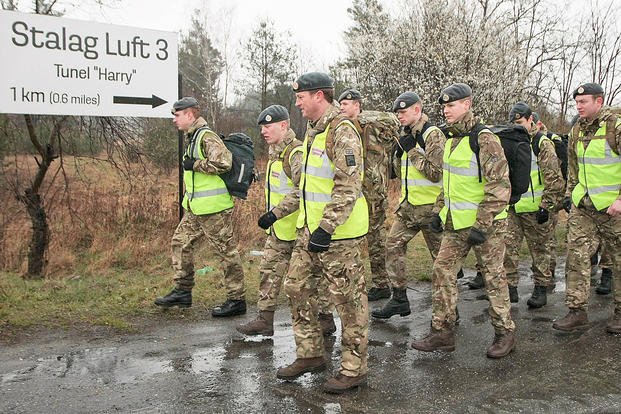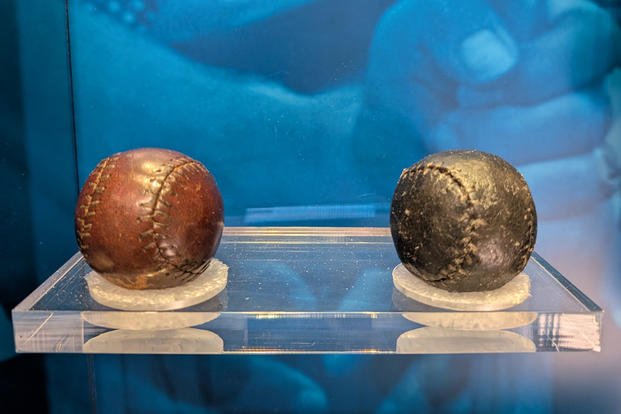It began with one used golf club, sent to a British military pilot detained in a German POW camp during World War II. Arriving in a Red Cross parcel but with no balls to hit, Sydney Smith had to get creative.
Carving a small chunk of wood until it was mostly round, Smith wrapped the wood in wool and cotton and stitched a covering to hold it in place. Once it was completed, he placed his handmade ball on the ground, grabbed his iron club and swung.
That simple act caught the attention of another POW, Pat Ward-Thomas, and soon several other imprisoned American and British airmen joined in at Stalag Luft III, the German camp made famous by “The Great Escape” in 1944 and the movie about that incident, starring Steve McQueen, two decades later. Before too long, these golfers began calling themselves the Sagan Golf Club, after the town in Poland (now called Żagań) where Stalag Luft III was located.
“You put all of these smart men in a confined space with nothing to do and you’d be not only surprised, but amazed, at what they’re able to create because of that situation,” Victoria Nenno, senior historian at the USGA Museum and Library in New Jersey, told CNN in 2024.
While the Nazis generally treated the detainees at Stalag Luft III better than at other German camps, according to a 1944 U.S. War Department report, they still struggled with scarce amounts of food, depression, and not enough clothing or fuel to protect them from the unrelentingly harsh winters. One thing Stalag Luft III had, though, was “the best organized recreational program of the American camps in Germany.” POWs were allowed to play a variety of sports, including soccer, cricket, softball and even rugby (until it was banned because the players were sustaining too many injuries).
Before the POWs could start playing golf, though, they needed to come up with enough balls and clubs. Because Smith was reluctant to share his only ball for fear it would be hit outside camp grounds or into a restricted area, each airman who wished to play had to make his own. One ball took approximately six hours to make and included a hodgepodge of materials, including rubber clipped from tobacco pouches, shoes or air cushions. Despite the wartime ration on rubber, friends (some in occupied countries) shipped the POWs actual golf balls, too.
They also sent clubs, giving Smith’s heavily used one a break; one estimate claimed it had hit in excess of 300,000 shots and been passed among the prisoners thousands of times.
Despite playing under the watchful eyes of guards, golf provided the POWs with a sense of normalcy. The Nazis looked on, probably with a mixture of indifference, ambivalence and bemusement. Sometimes a ball would be hit over a barbed-wire fence, and if a passing guard were so inclined, he might retrieve it. The Germans even went so far as to provide golfers with white jackets for whenever they struck a ball into a forbidden area — the attire symbolizing their true intention and that they were not trying to escape (decreasing the likelihood that they might be shot for any behavior deemed excessively brazen).

The Nazis did occasionally crack down on the golf games, including after the Great Escape. Suspecting them of conspiring in the plot in which 76 airmen escaped — 73 were recaptured, with 50 of them executed on Adolf Hitler’s orders — they ordered the destruction of a rudimentary course that the POWs had developed. After the prisoners pleaded vociferously, the guards finally relented and allowed the course to be rebuilt.
The matches were a form of escape for the POWs. While they enjoyed golfing, they were competitive, sometimes gambling on the results. They held hole-in-one contests and a club championship called the Sagan Golf Open, which Ward-Thomas won. Ward-Thomas, who later became an acclaimed sportswriter, sent an account of the match to the famed Royal and Ancient Golf Club of St. Andrews in Scotland, which showed its appreciation by shipping the POWs some balls and clubs.
“When they say truth is stranger than fiction, I feel like this is one of those moments because it’s such a mix of interesting things,” Nenno said in her interview with CNN. “A sport being played in a place that’s sort of unfathomable to enjoy any sort of recreation, let alone something we see as needing a proper course, needing proper equipment … These men made do with very little in order to make their experience better.”
The prisoners continued to play until the Germans abandoned Stalag Luft III in January 1945 to stay ahead of the approaching Soviet forces. Marching in horrific conditions, the POWs dispersed to other detention camps, their golfing days in captivity stopped but never forgotten.
Want to Know More About the Military?
Be sure to get the latest news about the U.S. military, as well as critical info about how to join and all the benefits of service. Subscribe to Military.com and receive customized updates delivered straight to your inbox.
Story Continues
Read the full article here





